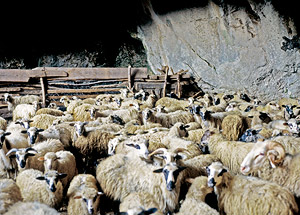During the last Ice Age, this region probably was inhabited by small bands of Paleolithic huntergatherers, just like the rest of the Mediterranean. At that time, the sea level was some 120 meters lower than today.
The entire northern Adriatic was dry land, a sprawling grassy plain supporting large herds of wild cattle and horses. Velebit Channel was a wide valley traversed by a river, while Velebit range itself was cold and uninviting, its highest reaches covered by glaciers.
Paleolithic huntergatherers kept close to their food sources, mostly located in valleys that were later flooded by the sea. Therefore, it is not surprising that we have not found any trace of them so far. It was only at the end of the Ice Age, when the sea levels began to rise, that the people had to seek out new ways of subsistence in higher, mountainous ground. They still hunted and gathered wild foods, but instead of cattle and horses, which disappeared together with the Adriatic plain, they hunted mountain goats and other animals inhabiting the rugged mountain terrain. The earliest evidence of human presence in the Velebit range, the unremarkable Mesolithic flint artifacts from the deepest layers of Vaganacka Cave near Veliko Rujno, belong to that period.




